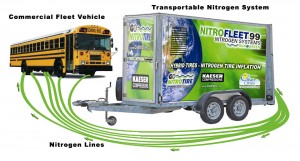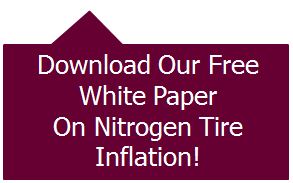 Increased fuel efficiency, longer tire life, and increased safety are just some of the benefits of having a nitrogen tire program in your fleet. Recognizing the benefits isn’t always the most difficult part. The toughest aspect is implementing such a program and ensuring that your managed fleet actually gets to see these benefits. Here’s how to implement a nitrogen tire inflation program into your fleet:
Increased fuel efficiency, longer tire life, and increased safety are just some of the benefits of having a nitrogen tire program in your fleet. Recognizing the benefits isn’t always the most difficult part. The toughest aspect is implementing such a program and ensuring that your managed fleet actually gets to see these benefits. Here’s how to implement a nitrogen tire inflation program into your fleet:
Assess the Cost and Carbon Savings
Nitrogen tire inflation will benefit one vehicle as well as a hundred or a thousand, but if you have a small fleet, then it might take a long time for your managed fleet to recoup the cost of the equipment. One nitrogen tire system can run several thousand dollars, so it’s important to consider the initial cost and how long it will take your fleet to recover that cost. The cost and carbon savings are much more substantial for larger fleets, and the initiative to go green may also be an additional incentive. A good place to start to calculate these numbers, if you are considering a nitrogen tire inflation program, is to use our carbon reduction calculator to get an idea of what you would save.
Make Your Purchase
This is an obvious step, but the hardest part is figuring out how many machines or inflation carts you need. Although this will differ from provider to provider, our nitrogen tire system can fill up to six tires simultaneously. It takes about seven minutes to purge those tires of air and to refill them with nitrogen.The number of machines that you purchase will depend on how many vehicles you have in your fleet, as well as how many locations your fleet has to do regular maintenance. For example, you could have a fleet of 1000 , but if there are five maintenance locations for your fleet, then you might only need 10 or 15 machines to ensure that each maintenance location is adequately serviced.
Transition Your Vehicles
Once you have your machines, the next step is to transition all of your vehicles. You want to purge them of the regular air and refill the tires with nitrogen. This is the only way to get your program started right, and to be able to track certain metrics. Your results will be skewed if you start by only topping off your tires with nitrogen, as the benefits won’t be as noticeable.
Educate Your Drivers
One of the most crucial elements in implementing a nitrogen tire inflation program, and in doing it successfully, is educating your drivers and maintenance workers about nitrogen tire inflation. This is more than telling them why the company is doing this and what nitrogen is supposed to do to the vehicle. It’s also about educating them on the importance of proper tire care i.e. checking tire pressure regularly, how to check tire pressure, when to do it, and what’s considered proper tire pressure. This ensures that while the vehicle is on the road, the tires aren’t over- or under-inflated on accident, which puts the driver at risk for a flat or a blowout. Nitrogen won’t make much of a difference in driver safety if the tire is over-inflated in the first place.
Track Certain Metrics to Measure the Savings
Once you implement the program and get everyone involved, you ought to track certain metrics to measure your savings and to show that the initial expenses were justified. Some of the metrics that you want to track include fuel costs, number of blowouts per month, average tire pressure upon maintenance, number of tire retreads per month, and length of a tire retread. Of course, you will need to track these metrics over several months to be able to see the benefits and the difference nitrogen made to your fleet. It would help if you had some or all of these numbers prior to starting the program, so that you can compare the results, but that’s not always necessary.







